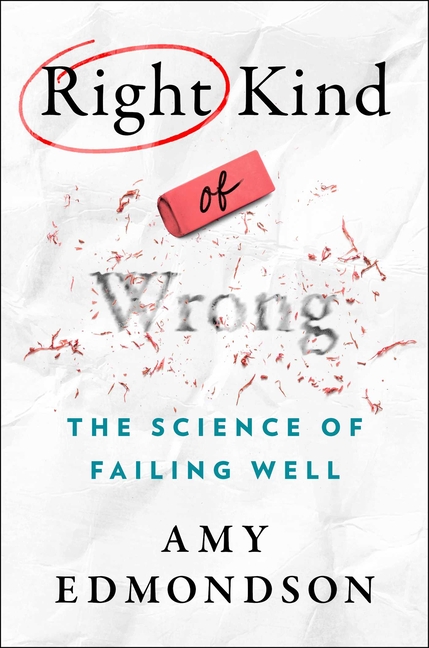Right Kind of Wrong | An Excerpt from the Management & Workplace Culture Category
December 14, 2023
A revolutionary guide that will transform your relationship with failure, from the pioneering researcher of psychological safety and award-winning Harvard Business School professor Amy Edmondson.
Failing is only a true failure when you neglect to learn anything from it. Amy Edmondson has gifted us with an entire book, The Right Kind of Wrong, that lays out the science of failing well—that is, using intelligent failures as a way to inform future successes.
The following excerpt come from the book's second chapter, which explains how failure fuels discovery.

An intelligent failure is an episode with a beginning and an end. An intelligent failure strategy, practiced by inventors, scientists, and innovation departments around the world, strings multiple intelligent failures together to progress toward valued goals. When we experiment, we hope our hypotheses are right. But we must act to know for sure. You might be experimenting with a new hairstyle rather than a chemical to separate RNA, but there is no substitute for action. In most cases, your action will require follow-up action. If you had read the earliest drafts of this chapter, you would have seen an ugly mess! A willingness to confront shortcomings and trust iterative improvement—with ample access to a trash bin (electronic or physical)—allows a book to take shape and make it to press. In any uncertain endeavor, a bias for action gets you started, but progress will require iteration.
Back when my sons were young, we would spend snowy weekends on the slopes of Wachusett Mountain in Massachusetts. My sons’ learning to maneuver their skis with increasing skill and grace—not to mention speed—was part of the fun. My younger son seemed to intuit the need for continuous improvement from an early age. Once, at about eight years old while still learning to ski, Nick asked me to watch him come down the slope. Dutifully, staring up the hill on an early-winter afternoon, I stood at the bottom and watched a small figure in a red parka carefully navigate the bumps and other skiers who sped by. When he reached me and asked, “How did I do?” I responded as I imagine many parents would, with an enthusiastic “You did great!”
His response threw me for a loop. Instead of the beaming smile I’d expected, he seemed puzzled. I saw the disappointment in his eyes as he asked, “Can’t you tell me what I did wrong so I can get better?” Psychologist Carol Dweck calls this a “growth mindset,” and it’s rare, especially when children grow up being praised for their every step. Most children over time internalize a belief in fixed intelligence and natural ability. Maybe because he had an older brother naturally able to do so many things better, Nick had an unusual appetite for honest feedback. He relished the right kind of wrong. For him, each run was an opportunity to get better.
If you’re wondering whether I, as a parent, had done anything right to nurture this attitude, I can only say that I was deeply familiar with Carol’s research, and I did my best to comment on process (“I’m intrigued by how you’re working with color”) rather than outcome (“What a beautiful painting!”). Albeit not in this particular moment on the ski slope. In retrospect, I could have said, “You were in control of your speed, and you looked like you were enjoying yourself. If you bend your knees a little more and keep your chest facing downhill, your form will be better.”
Learning from intelligent failure can be slow, whether in our lives or in the technology that shapes our world. Sometimes it takes decades, with multiple people building on others’ failures. Take the traffic light, an invention that underwent a stop-and-go journey much like the traffic it now controls. First invented by railway manager John Peake Knight and installed in London in 1868, the system was powered by gas lamps and required a police officer to stand beside it and operate the signals. A month later, a police officer “was badly injured when a leak in the gas main caused one of the lights to explode in his face.” Traffic lights were pronounced a public health hazard and the project stopped.
Forty years later, when automobiles hit the roads, the need for traffic lights became more urgent. A number of iterations were tried in the United States throughout the early decades of the twentieth century, with the first electric traffic signal—patented by James Hoge, whose design included the illuminated words stop and move—installed in Cleveland, Ohio, in 1914. But it fell to inventor and businessman Garrett Morgan to improve upon previous iterations with an idea in 1923 that brought the traffic light closest to the ones we have today.
The story goes that Morgan witnessed a spectacular accident at an intersection in downtown Cleveland that was already using a traffic light. The failure—as he saw it—was that the lights switched between stop and go without any interval between, giving drivers no time to react. Morgan’s invention, which he patented and sold the rights to, to GE, was an automated signal with an interim warning light—the precursor to today’s yellow light.
Other times, the time frame for experimentation is relatively short, even with several iterative failures on the way to success. Take Chris Stark, who wanted to find a use for the fallen apples he saw going to waste every autumn in New England. Make apple pies? Not a viable solution because the number of pies anyone can eat or store is limited.
Applesauce? Same issue.
Apple cider, he decided, was viable because the liquid could easily be stored and used for many purposes.
Now, to act. He engineered a drum with screws to break up the apples. But how to turn the device? First, he attached a bike crank. That failed because it required more effort than people were willing to exert. Next, he hooked up the drum to an old bicycle and used pedal power. That, too, failed; the chain flew off, making it dangerous to operate. In attempt number three, Stark attached an exercise bike to a platform, making it stationary, which was the charm in building his “exercider.”
Attending to the results carefully to determine why a failure happened is paramount. Was it a simple matter of a chemical mix-up? Then the failure is basic rather than intelligent. If you had a hypothesis and it was wrong, remind yourself not to be too disappointed, but rather to be curious. Why was it wrong? What did you miss? Train yourself to care more about the new information the failure brought than about being wrong. You can take solace in the fact that it was an intelligent failure! But intelligent failures’ lessons don’t announce themselves. Take the time to diagnose the miss carefully. Ask, What did I hope would happen? What happened instead? What might explain the difference? This work can be painstaking, but it always points toward a better way. It clarifies what to try next.
Excerpted from RIGHT KIND OF WRONG published by Atria, a division of Simon & Schuster, Inc. Copyright © 2023 by Amy Edmonson.








